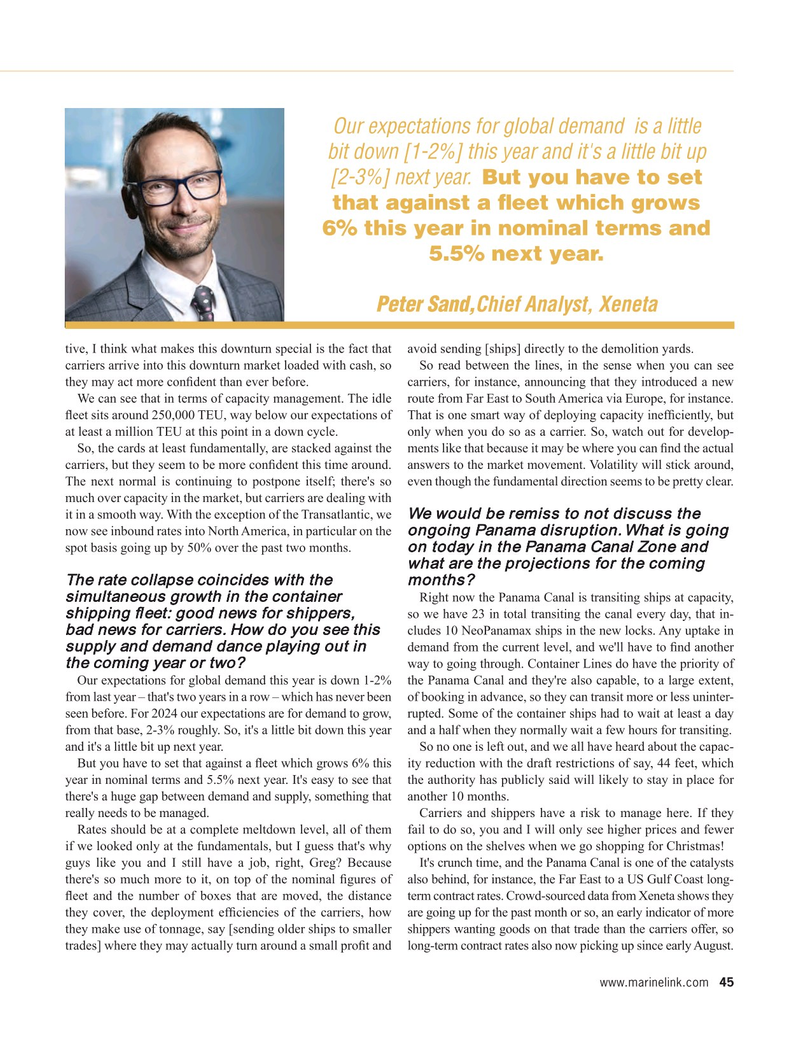
Page 45: of Maritime Reporter Magazine (September 2023)
Marine Design Edition
Read this page in Pdf, Flash or Html5 edition of September 2023 Maritime Reporter Magazine
Our expectations for global demand is a little bit down [1-2%] this year and it's a little bit up [2-3%] next year. But you have to set that against a ? eet which grows 6% this year in nominal terms and 5.5% next year.
Peter Sand,Chief Analyst, Xeneta tive, I think what makes this downturn special is the fact that avoid sending [ships] directly to the demolition yards.
carriers arrive into this downturn market loaded with cash, so So read between the lines, in the sense when you can see they may act more con? dent than ever before. carriers, for instance, announcing that they introduced a new
We can see that in terms of capacity management. The idle route from Far East to South America via Europe, for instance. ? eet sits around 250,000 TEU, way below our expectations of That is one smart way of deploying capacity inef? ciently, but at least a million TEU at this point in a down cycle. only when you do so as a carrier. So, watch out for develop-
So, the cards at least fundamentally, are stacked against the ments like that because it may be where you can ? nd the actual carriers, but they seem to be more con? dent this time around. answers to the market movement. Volatility will stick around,
The next normal is continuing to postpone itself; there's so even though the fundamental direction seems to be pretty clear.
much over capacity in the market, but carriers are dealing with it in a smooth way. With the exception of the Transatlantic, we
We would be remiss to not discuss the ongoing Panama disruption. What is going now see inbound rates into North America, in particular on the on today in the Panama Canal Zone and spot basis going up by 50% over the past two months. what are the projections for the coming
The rate collapse coincides with the months?
simultaneous growth in the container
Right now the Panama Canal is transiting ships at capacity, shipping ? eet: good news for shippers, so we have 23 in total transiting the canal every day, that in- bad news for carriers. How do you see this cludes 10 NeoPanamax ships in the new locks. Any uptake in supply and demand dance playing out in demand from the current level, and we'll have to ? nd another the coming year or two?
way to going through. Container Lines do have the priority of
Our expectations for global demand this year is down 1-2% the Panama Canal and they're also capable, to a large extent, from last year – that's two years in a row – which has never been of booking in advance, so they can transit more or less uninter- seen before. For 2024 our expectations are for demand to grow, rupted. Some of the container ships had to wait at least a day from that base, 2-3% roughly. So, it's a little bit down this year and a half when they normally wait a few hours for transiting. and it's a little bit up next year. So no one is left out, and we all have heard about the capac-
But you have to set that against a ? eet which grows 6% this ity reduction with the draft restrictions of say, 44 feet, which year in nominal terms and 5.5% next year. It's easy to see that the authority has publicly said will likely to stay in place for there's a huge gap between demand and supply, something that another 10 months.
really needs to be managed. Carriers and shippers have a risk to manage here. If they
Rates should be at a complete meltdown level, all of them fail to do so, you and I will only see higher prices and fewer if we looked only at the fundamentals, but I guess that's why options on the shelves when we go shopping for Christmas! guys like you and I still have a job, right, Greg? Because It's crunch time, and the Panama Canal is one of the catalysts there's so much more to it, on top of the nominal ? gures of also behind, for instance, the Far East to a US Gulf Coast long- ? eet and the number of boxes that are moved, the distance term contract rates. Crowd-sourced data from Xeneta shows they they cover, the deployment ef? ciencies of the carriers, how are going up for the past month or so, an early indicator of more they make use of tonnage, say [sending older ships to smaller shippers wanting goods on that trade than the carriers offer, so trades] where they may actually turn around a small pro? t and long-term contract rates also now picking up since early August. www.marinelink.com 45
MR #9 (34-49).indd 45 9/6/2023 4:47:11 PM

 44
44

 46
46
